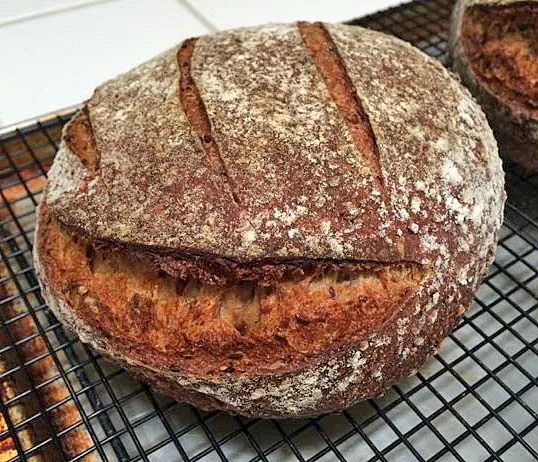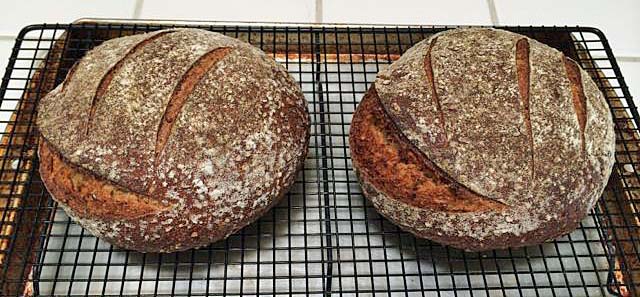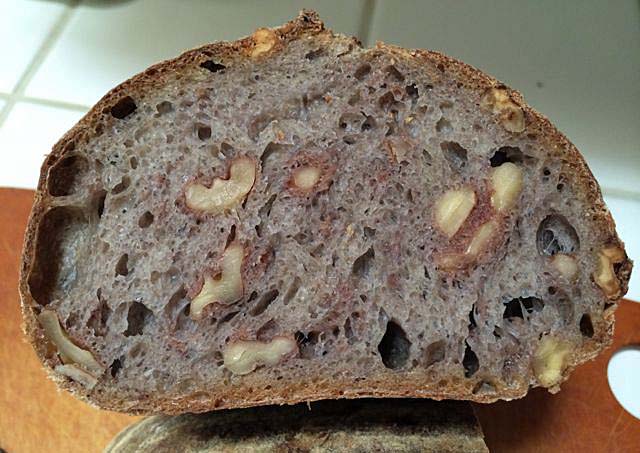
Yesterday, I baked the "Finnish Rye" from the SFBI for the second time. It is a delicious bread, although what makes it Finnish and why it's called a rye, since it has less rye than either white or whole wheat flour, remains mysterious. I described how I made it in my previous post ("Finnish Rye" from the SFBI.


I also made a walnut bread. I have made walnut breads based on my San Francisco-stye Sourdough before, and it has been good. This time, I use my SFSD with increased whole wheat (San Francisco-style Sourdough Bread with increased whole wheat flour) as the base, and I think it's even better.


Happy baking!
David
- dmsnyder's Blog
- Log in or register to post comments
David: More recipes for me to try! I love nuts in bread. Will be wonderful toasted, too! Phyllis
It is wonderful toasted. It may seem "totally nuts," but this bread is truly delicious toasted then spread with almond butter. But it's not bad untoasted plain or with a little sweet butter.
David
Hi David. Beautiful as usual. The walnut is always a favourite addition to my breads. That and fig.
I applaud the increase in whole wheat flour for it. A walnut bread screams for more wheat and whole grain flours.
Yum!
John
You have seen my SF SD with figs and walnuts, haven't you? Unfortunately, this past Fall's crop of dried calmyrna's was nowhere near as good as the preceding years' crop.
If you really like nuts in bread, take a look at this: Potato-Nut Bread from South Tyrol (Thanks, Salome!) Hmmmm .... It's been a very long time since I made that bread. It was really nice.
David
Yes I have seen it David! In fact, when I baked my first fig walnut loaf, it was again, your post that I got ideas and inspiration from. You seem to do that quite a bit for my bakes :) Thank you. And I will check that Potato-Nut Bread out.
John
I love how the tannins make the dough purplish. Kind of bruised looking, so makes a good Halloween dough!
The Finnish Rye is crying out for butter. Maybe even crying out to be toasted.
I hear these things.
The Finnish Rye got almond buttered for breakfast. Yum!
I toasted the walnuts for 8 minutes at 300 dF (convection). They would also be good toasted darker. I've done up to 15 minutes at 350dF when I really want a toasty flavor.
It's amazing what you can hear. I couldn't pick the Finnish Rye's cry out from the racket made by all the breads in my freezer begging for attention.
David
David. Don't know why a 21% rye would be called a rye either but it seems to be common with rye breads for some reason like a 30% Jewish Deli Rye. Why it is Finnish must be because it is finished off and gone so fast :-) I thought Finnish Rye had much more rye in it though?
Your rye is nice and dark due to the molasses no doubt. Wonder if that makes it Jamaican or Cuban? Love the extra WW for the base if the walnut bread too. Very tasty and healthy. Well done as usual David.
Yes. The molasses is the major contributor to the crumb color. Also to the bread's flavor on day one.
Your theory is that "Finnish" bread is related to "Moreish" bread. Hmmm ... I don't have a better theory.
David
I've wanted to try that Finnish Rye since the first time you posted it. Looked so good. Again it looks fantastic. The to do list is getting way too long. In fact I'm staged with your SFBI Miche as we speak just waitin on the levain to ripen. Taken longer than I expected.
Love the crumb on the walnut bread.
Your breads lookin stellar as usual
Enjoy
Josh
The Finnish Rye is very tasty, unless you dislike the taste of either molasses or flax seeds.
It is a challenging dough, and I would love to have the benefit of your thoughts about it. I'll just say that, again, I added about 30 to 50g additional water during the mixing before adding the soakers. The dough is incredibly sticky, yet not really loose. It has a unique consistency. I'm wondering if it really needs a long autolyse. The SFBI instructions don't call for one. Hmmmm .... Maybe I should email Michel and ask what he thinks.
David
I'll get to it here in the next couple weeks and let you know how it goes. I'd like to omit the yeast and do an overnight retard in form after looking the formula over. Only because I've been avoiding commercial yeast as much as possible. To live without a true baguette might be okay if it means more miche and whole grain loaves to cover the void. I'll keep everything else as you have it written. You did mention in the first post decreasing the molasses. Is the bread very sweet with that much molasses?
As for it being a Rye. Think of it this way. The white and wheat are both wheat and the real player that makes the flavor profile unique must be the 22% Rye (and of course the soaker). Just like the P.M.
Once Rye breaks the 10% range or so in bread I can feel it's tackiness in a dough. The more rye, the more so. Pane Maggiore I think is most difficult to shape not due to hydration but because of its sticky nature. Then in this loaf you have added molasses and soaked flax seeds. Soaked flax seeds are like glue in my experience. I think that is why it has an interesting and probably difficult to work with feel even at reasonable hydration.
Could toasting the flax and adding it during the folds and upping hydration of dough (for lost h20 from soaker) be a potential solution to the dough feel without sacrificing flavor/texture?
I can't wait to get stuck on this one.
Josh
Yikes! I forgot to mention in the OP that I retarded the formed loaves overnight. I just ran out of time to bake the loaves on day two. We had a concert to get to. So I took a chance and stuck the loaves in the fridge. Honestly, I couldn't tell any difference at all. I still let them proof at room temp. for a couple hours before baking.
I think you articulated my sense precisely regarding the 4 kinds of stickiness this dough exhibits. The reason I brought up the autolyse idea is that, on the morning I baked them, the loaves were not sticky at all. But, of course, that was just the surface.
Regarding toasting the flax seeds. I don't know. I imagine they would seem rather oily if toasted. Good for polishing your Danish modern furniture. At one time, I understood that soaking flax seeds makes them digestible. More recently, I've read that flax seeds are only digestible when ground. So, what I've been using doesn't make its beneficial insoluble fiber available?
David
If they work overnight with yeast they will do so as well without. I've noticed in some reputable books I own some formulas skip the all mighty autolyse. None actually give reason as to why in that particular formula why it is omitted. One reason I can gander would be to not create more protease and add more elasticity to the dough. So in this case with the hefty amount of whole grain plus the soaker that makes some sense. But it could also be because so much of the hydration is not in the final dough that it only makes sense to incorporate all the parts.
Maybe this dough would do well with bulk retarding which would allow you to shape the dough cold and potentially make it easier to handle and result in better forms?
I wonder if fermenting the soaker with a touch of sourdough overnight would make it more digestible.
it's fun how one formula for bread can be handled so many ways with successful outcomes.
Time to shape the Miche (so fun shaping 2 KG loaves)
Josh
But, I believe it is the soluble fiber you don't get the benefit of. The insoluble stuff passes thru (and gives the benefit) ground or not. But you really miss out on the tremendous benefits of flax if the seeds are not ground. So if dying them whole, chew, chew, chew! Use nature's grinder.
Maybe better to make meal out of some and keep some whole for texture?
Wonderful job there David. Superb crumb.
Best,
Syd
David
Nice looking loaves David. Especially like that Walnut loaf.
Regards,
Ian
David